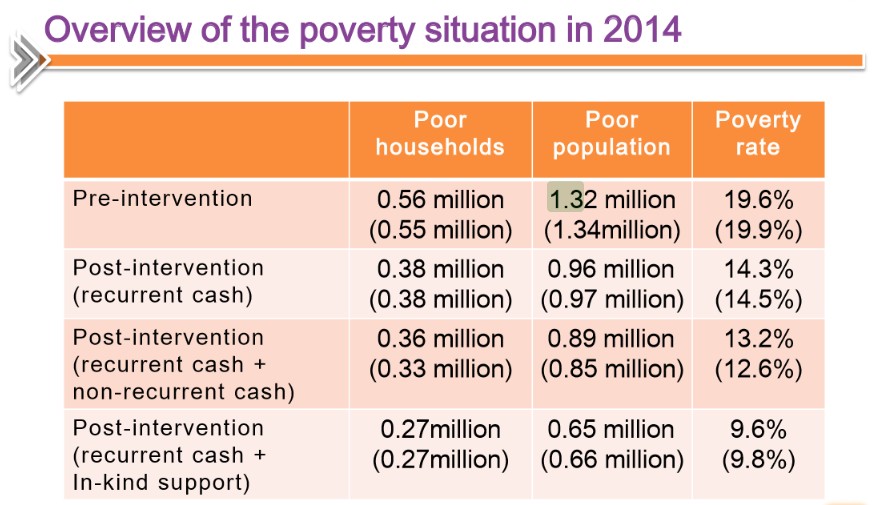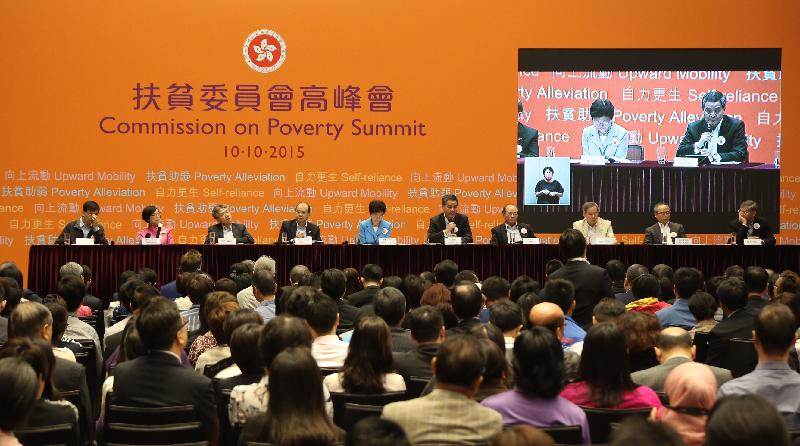Following the recent release of the 2014 Hong Kong Poverty Situation Report, government officials including Chief Secretary Carrie Lam began giving themselves pats-on-the-back for the “record-setting” low number of people now living under the poverty line. Government statistics report a staggering 1.3 million people living in poverty, a figure that still hovers close to one million after accounting for welfare benefits. However, this is no cause for celebration.

As the saying goes, the devil is in the details. Tucked within the detailed report are various statistics that shed additional light on the plight of the have-nots in one of the world’s wealthiest metropolises.
- Hong Kong’s poverty line is defined as half the median income for a given household size. This currently equates to monthly earnings of $3,500 for an individual and up to $18,800 for a family of six.
- The total number of persons below these thresholds fell by 1% this past year. The report hails this accomplishment, but after looking at historical changes in the size of the poor population, one finds that a 1% drop is not statistically significant. In inferential statistics one must consider whether an observed effect could have occurred due to a sampling error. In this case, one can only conclude with 83.5% certainty that the 1% drop was statistically distinguishable from zero. Contrary to the government’s claims, there was no meaningful change in the number of poor people.
- Poverty is especially prevalent among the elderly. Despite deceptively promising headline numbers, the number of elderly living in poverty rose by a whopping 4.4% (statistically significant with 98.4% certainty). The elderly poor typically live alone or with their spouse; consequently, the number of poor residing in one- and two-person households also rose, by 3.8% and 1.0% respectively. The government lists the poverty rate among elderly at a shocking 72% before welfare benefits and 47% after.
- The report acknowledges the rise in elderly poor, but attributes the increase to methodological deficiencies, pointing out that most elderly are retirees with no income who thus fall below the earnings thresholds. These comments hardly constitute an explanation and only strengthen criticisms of Hong Kong’s social welfare, nominally present but lackluster in practice (consider the Old Age Living Allowance of $2,200, typically referred to as “fruit money”). The statistics also reinforce the dire need for universal retirement protection.
- The poverty line for individuals remains unchanged from its 2013 level. The lines for two- and three-person households have inched upward slightly to reflect rising living costs, but are well less than the inflation rate. One finds it extremely suspect that in the entire 200-page report, the term “inflation” is mentioned only once. Inflation, as measured by the Census and Statistics Department’s Consumer Price Index (CPI-A, calibrated to spending patterns of low income groups), has averaged 4.5% in the past five years. Simply put, the official poverty line understates the number of poor.
- Adjusting for inflation, the poverty line for individuals is up from $3,500 to $4,115. Given that income distributions are heavily skewed, raising this threshold by a meager $600 is likely to classify many more persons as “poor”. Using demographic data from the C&SD General Household Survey report and rudimentary extrapolation techniques, one approximates an additional 284,000 people living under this “revised” poverty line, bringing the total number of poor to 1.6 million, compared with the government’s 1.3 million, a 21% increase. Poverty is not decreasing, it is rapidly on the rise.
- The number of poor youth households rose by 10%, which is partially attributable to worsening housing affordability and declining job prospects. Competition for well-paying jobs in sectors like finance continues to rise, facilitated by a lack of government effort to encourage large corporates to hire local talent, making it increasingly easy to recruit foreign nationals. These often favor candidates with mainland connections and backgrounds. Young people entering the workforce thus must turn to low-wage sectors such as retail and restaurants/catering, where there are ample “dead-end jobs” fueled by economic growth from Chinese tourism.

Make no mistake, Hong Kong’s poverty situation remains an outright disgrace. Average wealth in this city surpasses some Western European countries, yet it is home to over a hundred thousand people living in rooftop slums and “coffin homes” (“subdivided flats”, to use a government euphemism). The recent death of a homeless woman sleeping in a McDonalds restaurant has brought renewed awareness of the not-so-uncommon phenomenon of “McRefugees” in the city. Another sight unique to Hong Kong are elderly pushing trolleys collecting recyclables or making deliveries, seen everywhere from wet markets to the bustling streets of Central. Not only lacking the resolve to tackle these problems, current and past administrations seem determined to continue transforming Hong Kong into a leisure center for China’s nouveau riche and local elites. It is no surprise that social welfare has become all but an afterthought.
